Page content
Dressing for the Occasion
By Mary Miley Theobald
When Franklin D. Roosevelt paid a visit to Colonial Williamsburg in October of 1934, he had good reason to keep his eye on the ladies. Welcoming the President that autumn day were six costumed hostesses splendidly dressed for the occasion in colonial style gowns. Yards of colorful, crisp fabric draped over wide hoops rustled softly as the ladies watched the President's touring car motor down the Duke of Gloucester. The height of fashion from two centuries past had returned to the colonial capital. FDR was charmed.
He wasn't the only one. On the strength of that visit, Colonial Williamsburg's Vice-President Kenneth Chorley approved the manufacture of costumes for all hostesses, beginning what was – then and now – the largest museum costuming operation in the country.
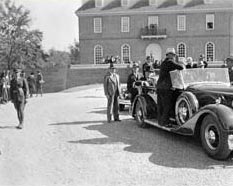 It could only have been a matter of weeks before the romance faded and cold reality set in. How
were the lovely costumes to be maintained? Who would launder them properly?
It could only have been a matter of weeks before the romance faded and cold reality set in. How
were the lovely costumes to be maintained? Who would launder them properly?
A local dry cleaner cleaned the first ones “so badly that it was still doubtful whether the collars and cuffs could ever be used again,” lamented one report.
Who would repair that torn hem? Who would alter them when one hostess left the job and another was hired? And what about comfort? The warm winter gowns would not be suitable when summer arrived.
What were the ladies to wear to work in cold or rainy weather–their own coats or rain gear atop their colonial attire?
When it became obvious that costuming a tour guide was more complicated than stitching up a dress, a permanent in-house costume department was proposed. Mrs. H.G. Cooley, the local seamstress who had sewed the first gowns in her home on Jamestown Road, agreed to become its supervisor. The cost per dress was pegged at $30.00.
Over the next few months, an enthusiastic Chorley added gaolers, janitors, coachmen, laundry and kitchen workers, and waiters to the list of employees who would work in costume.
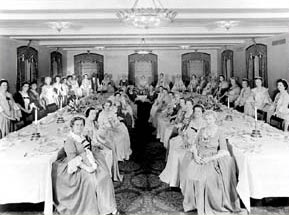 “It would seem inconsistent to omit the costumes of the period which, after all, were one of the most
colorful and important adjuncts to the life of that day. . . Williamsburg has a wider
scope than that of being an architectural and historical Restoration. Other
phases of eighteenth-century life, as well as the historical events and the
buildings in which they occurred, played an important part.”
“It would seem inconsistent to omit the costumes of the period which, after all, were one of the most
colorful and important adjuncts to the life of that day. . . Williamsburg has a wider
scope than that of being an architectural and historical Restoration. Other
phases of eighteenth-century life, as well as the historical events and the
buildings in which they occurred, played an important part.”
Chorley backed his words with action. In less than two years, 53 employees were wearing costumes and two seamstresses and two laundresses were busy serving them.
“In the past, costuming in this country has been more for effect than for accuracy,” Chorley wrote. It would not be that way at Colonial Williamsburg. “The Restoration has made a careful study of old costumes, prints, portraits, and records dealing with 18th century dress both in this country and abroad in order that the costumes worn in the Exhibition Buildings should be accurate in every possible detail.”
To back up the costume program, Curator James Cogar began purchasing articles of antique clothing to use as models.
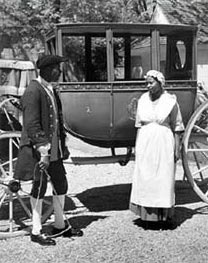
Employees representing 18th century domestics model typical costumes available in 1950. Colonial Williamsburg's increased emphasis on authenticity made these costumes obsolete.
The new costume department was located in the stables at the Governor's Palace. For many years an effort was made to incorporate the sewing and laundering into the other activities performed before the public. Some of the costumes were laundered the old way and hung outside on lines to dry. The debate on ironing–whether to use electric irons behind the scenes or the old style flatirons before the public–raged for years.
The Second World War intervened. Rationing made textiles scarce and for almost a year, the costume operation shut down entirely. Existing costumes wore out and could not be replaced.
After the war, the craft shops reopened and waiters were put back into costume. A tailor joined the rehired seamstresses and the whole operation moved to the rooms above the Margaret Hunter Millinery Shop. As new buildings opened to the public and programs grew, more demands were placed on the men and women who sewed. For the first time children were added to the list of costumed personnel and so were maids, coachmen, concert players, militiamen, and play actors, bringing the total number of people costumed in 1952 to around 230.
As if they didn't have their hands full sewing clothing, the seamstresses and tailors were regularly asked to perform other needlework tasks. They repaired worn carpets, the tapes on Venetian blinds, the flag that flew over the Capitol, and table coverings. They made curtains for the stage, sewed slipcovers, and embroidered fabric for one of the coaches. And by 1968 they were producing clothing for 533 individuals.
The trend toward synthetic fabrics in the sixties brought with it a problem: fewer natural fabric options. A decision to focus the clothing styles on the 1760s and 1770s instead of the 1740s made it necessary to replace the widest side hoops with a more moderate bulge or none at all. It was credible colonial dress but not terribly authentic by today's standards. There was no attempt to use stays and the synthetic fabric colors were not true to the eighteenth century.
Preparations for the Bicentennial brought concerns about the cost of costuming all the extra personnel necessary to handle the anticipated crowds. As an experiment, red, white, and blue polyester knit suits were ordered for the summer hostesses in 1973.
“It was a disaster,” recalls Peter A. G. Brown, retired vice-president. “Visitors were confused and disappointed. `No thank you, dear, we'd like a real tour guide,' they would say to the hostesses. We received a good bit of mail and many vocal complaints.”
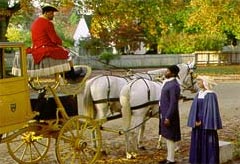
Joe Jones, driving the Wythe chariot, pauses in front of Bruton Parish Church to speak to African American character interpreters Robert M. Watson Jr., and Sylvia Lee. All three are costumed for their roles as urban household slaves.
The experiment was abandoned at the end of the summer. The public had come to associate costumed personnel so closely with Williamsburg that their experience was seriously devalued without them.
With the eighties came an increased emphasis on authenticity throughout Colonial Williamsburg and the costume department was no exception. More research into primary documents such as the clothing descriptions in runaway slave ads added immeasurably to the body of knowledge surrounding clothing, colors, and wearing habits. No longer would any plain black shoe or one's own modern eyeglasses suffice. Standards of appearance tightened. Formal balls and assemblies, more children, and a variety of special events necessitated many new sorts of clothing. Interpreters portraying characters in court trials, funerals, and weddings needed accurate clothing beyond what had been contemplated for tour guides, craftspeople, and waiters.
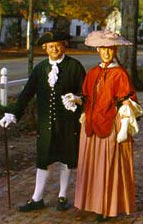
Representing a prosperous gentry couple, Charlie Red and Lisa Kause stroll Duke of Gloucester Street in their "middling sort" finery
Finding correct fabrics remains a continuing challenge. Good solids are relatively plentiful; authentic prints are not. The Costume Design Center relies on reproduction drapery and upholstery fabrics but often the large scale of the print will not translate to wearing apparel. Good silks are available but at $100 a yard or more. When a dress takes ten or more yards of material, silk can break the budget. Only natural fibers--silk, cotton, linen, and wool--are used, with the rare synthetic exception made for an employee allergic to wool. “It is better for the appearance of the costume and for the comfort of the employee to use the 100% natural fabrics,” says Rick Hill, Manager of the Costume Design Center.
Today the Costume Design Center employs 28 people, 23 of whom sew the clothing for 500 to 800 people. “But remember,” cautions Hill, “many of those employees have more than one position, for example, a craftsperson who also dances at Palace balls and acts in a theater production requires two or even three types of costumes. We count positions rather than people; there are about 1200 positions that we costume.”
A full-time employee has three to six outfits that are expected to last anywhere from one to ten years. All in all, Hill estimates that his people make and maintain about 60,000 separate clothing items. The inventory is tracked by computer.
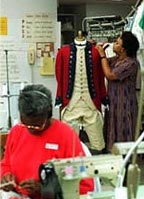
Clarissa Brinkley (right) checks regimental facings on a military costume, while Arlene Jeanes handles repairs.
The never-ending problem is the human one–growth. Fife and drum corps members shoot up in sudden spurts, a tour guide gets pregnant, a craftsperson loses weight. “With pregnancies,” explains Hill, “we can alter the dress to a point, but then we use looser fitting clothing during the later months.”
To most people's surprise, the shape of the human body has changed substantially since the eighteenth century. In those days, women were corseted from childhood and, while these weren't the very damaging stays of the nineteenth century, they did shape the body differently by shaping the rib cage. A conical form was the ideal with the bust up, the shoulder carriage back, and shoulders sloping downwards–a complete reversal of the fashionable silhouette from then to now. To design an eighteenth-century look on a twentieth century body is challenging, but Hill and his seamstresses come close as anyone can.
In the last fifteen years they have tried to present a more authentic picture by developing stays. “I doubt we will ever require the wearing of stays,” says Hill, “but we are getting more volunteers all the time. About 125 women wear the lightweight version called half-boned stays. They give a very good facsimile of the period. . . very close.”
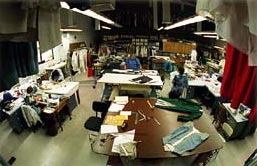
In the center's production room Terry Lyons lays out patterns for a pair of breeches.
After fifty-five years of being housed in hand-me-downs, the Costume Design Center found its permanent home in a custom-made building just outside the Historic Area. On any given day, the site bustles with activity as employees drop off or pick up costumes from the laundry, stop in for fittings, or discuss repairs. There is a large storeroom with bolts of silks, cottons, linens, and wools, and hundreds of buttons, buckles, ribbons, laces, and trims. Not all costume accessories are made at the department: shoes, for instance, are contracted from a Wisconsin company; stockings in appropriate colors, mitts (fingerless gloves), and eyeglasses are made to specification elsewhere. In the accessories room there are neckerchiefs, cravats, straw hats, caps, aprons, muffs, pearls with ribbon ties, bows, and some jewelry.
The production room is divided into four main teams: men's, women's, children's, and maintenance. “We specialize, but for special events like a new tour or for rush jobs, everyone overlaps and pitches in.” Hill has been manager less than a year but he has seen costuming from all sides. He held the costume research and design job for several years and before that, he worked in costume himself, as the tailor in the Historic Area craft shop.
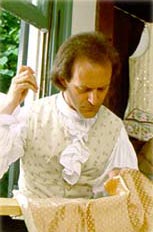
Adept with needle and thread, Rick Hill, manager of the Costume Design Center, knows clothing construction from every perspective. He formerly was Colonial Williamsburg's tailor.
The R&D people at the Costume Design Center study antique costumes and accessories every chance they get. Nancy Glass, a veteran who has worked in costuming for over 30 years, has traveled to museums like the Metropolitan in New York, the Los Angeles County Museum of Art, the Valentine in Richmond, and the Royal Ontario Museum to examine antique clothing and produce patterns from them.
A Costume Approval Board was established some years ago to act as a control for newly developed costumes and accessories. They work with research and construction techniques, examine primary sources such as period prints, portraits, antique garments, diaries, and written descriptions, and they investigate the etiquette of clothing, the when and how articles of clothing were worn. The Approval Board also assists employees who want to supplement their wardrobe with pieces of clothing or accessories they have made themselves.
What do they do with all the leftover costumes? Just as in the old days, articles of clothing are used until they are literally worn out. Some are returned to the historic area in the form of rags: the gunsmith shop and the powder magazine, for instance, use rags to clean their guns.
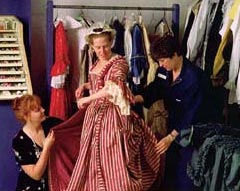
It's time for Martha Washington's final fitting. Guenivere Lee (left) and Frances Loba (right) check Susan Berquist's new gown.
Colonial Williamsburg's costume operation has a reputation that spans the globe. Nancy Glass recalls, “Over the years, we have had many interns come to study with us and frequently we are asked for help in setting up historical costume programs for other museums. Most recently, museums from the Dominican Republic, Australia, and South Africa have come to us for help and we are always glad to work with them in any way we can.”
Everyone involved in historic clothing agrees, the difference between costume and historic clothing is in the details. A theater costume can get away with synthetic fabric, zippers, and less accuracy because it isn't meant to be seen up close. The historical interpreters at Colonial Williamsburg come within inches of hundreds of visitors a day. “Our biggest challenge,” says Hill, “is to keep the entire person looking eighteenth century.”
